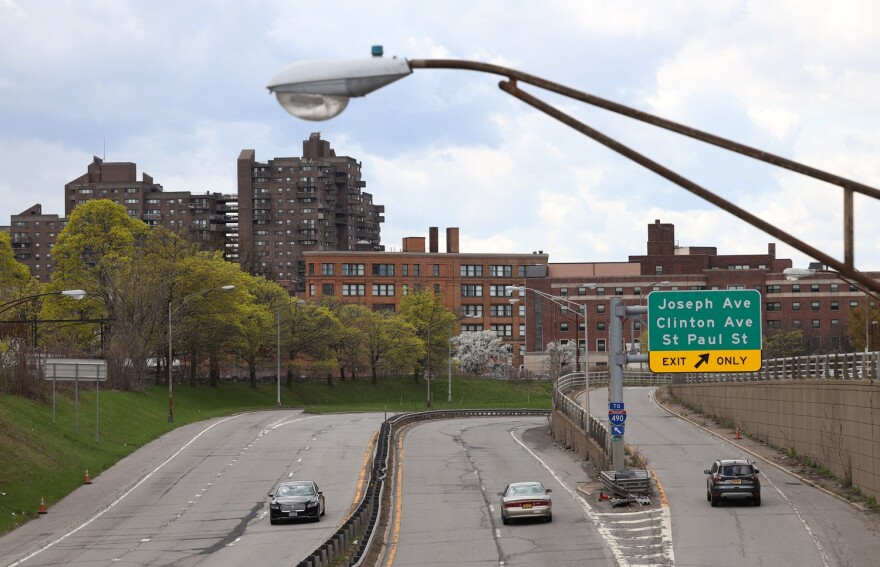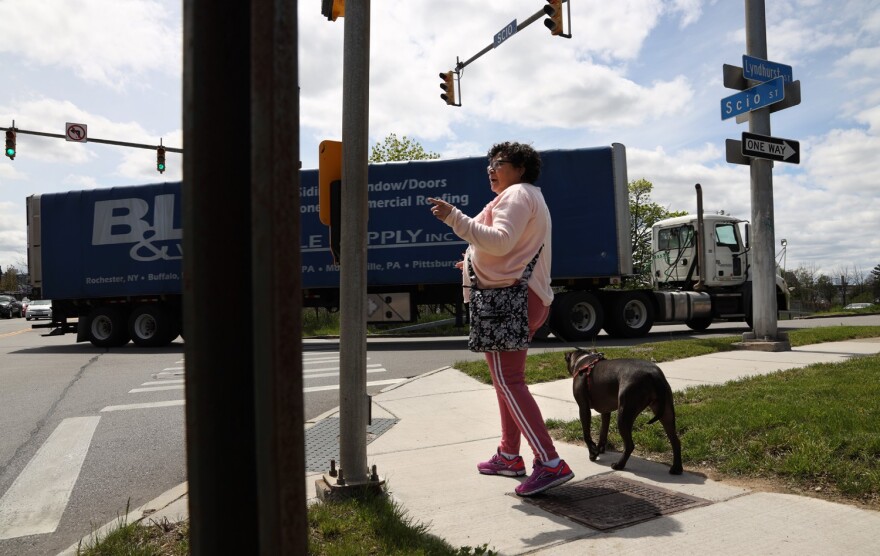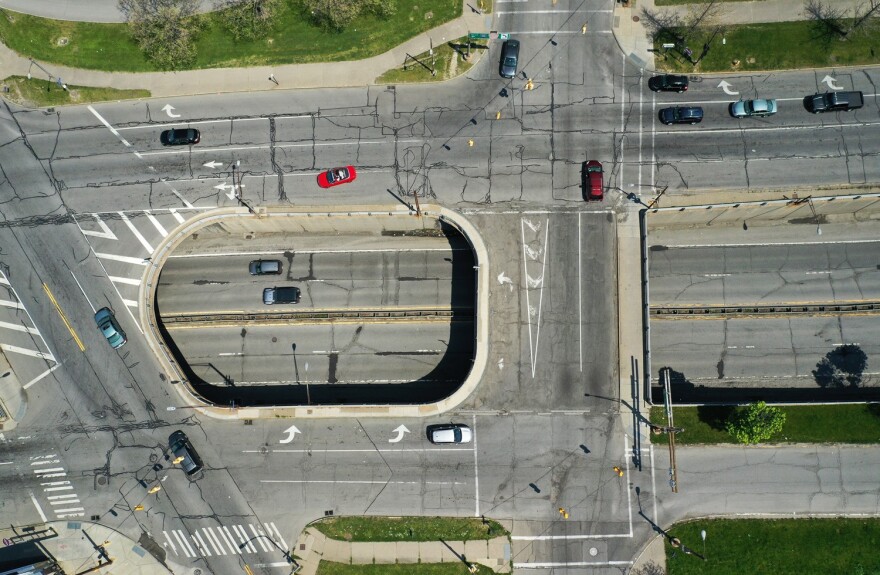Norman Jones is old enough to remember the Inner Loop being built more than half a century ago.
“I have a clear memory of that machinery,” Jones said. “When you’re 4, 5, 6 years old, and you see big trucks and the excavators, you go, ‘Wow.’ When you see it all moved around, you just thought it was the coolest thing, and probably everyone else thought it was the coolest thing.”
The 63-year-old commissioner of the city Department of Environmental Services keeps two outsized frames hanging on the wall of the agency’s conference room at City Hall that act as his guides when he considers the future of the sunken expressway.
One frame holds a collage of photos detailing the housing and retail developments that have shot up on the eastern edge of downtown on the filled-in portion of the Inner Loop. In the other is an annexation map of Rochester from 1950, before the expressway cut a circular path around downtown that separated neighborhoods from the city core like a concrete moat.
The latter reflects the Rochester that Jones knew only briefly as a young boy — and the one he wants back.

Now, he and other city officials hope they can get it back, with President Biden looking to spend an unprecedented $2.3 trillion on infrastructure that emphasizes not only moving people and goods around more quickly, but correcting what have come to be seen as transportation mistakes of yesteryear.
“Too often, past transportation investments divided communities . . . or it left out the people most in need of affordable transportation options,” read a White House fact sheet outlining the Biden administration’s intentions, dubbed the American Jobs Plan.
“The president’s plan,” the fact sheet went on, “includes $20 billion for a new program that will reconnect neighborhoods cut off by historic investments and ensure new projects increase opportunity, advance racial equity and environmental justice and promote affordable access.”
For Jones, and countless residents of Rochester and its suburbs, doing away with what’s left of the Inner Loop dovetails perfectly with the president’s vision.
The 2.68-mile Inner Loop was completed in 1965 and was intended to move motorists quickly in and out of what was then a burgeoning Rochester. But many longtime residents say the urban-renewal-era roadway irrevocably altered the character of the city and their neighborhoods. Within 25 years, officials were talking seriously about getting rid of at least part of the roadway. It would take nearly 25 more years for action.
Over the last eight years, the eastern portion of the Inner Loop was filled in, and development is well underway. Jones, who was integral to bringing the idea of filling in the so-called Inner Loop East to the fore, is again a key official in an effort at City Hall to get rid of the rest of the loop.
He figures burying it would reintegrate about 22 acres — roughly 16 football fields — into the cityscape. Jones estimates the job could cost anywhere between $70 million and $300 million — a range he attributed to having not settled on what would eventually be built on top of the highway.

The price tag would make filling in and developing the rest of the Inner Loop one of the costliest city public works projects in decades. But Jones urges skeptics to consider the potential benefits.
City officials often boast that more than $300 million of private investment followed the roughly $25 million it cost to fill in the smaller, eastern portion of the highway. That project relinked the East Avenue and Park Avenue neighborhoods with downtown. Doing away with the remaining northern section would do the same to some of Rochester’s poorest neighborhoods.
For Jones, the matter is personal. He recalls growing up off Joseph Avenue and walking downtown with his brothers to catch a movie or buy candy at a Woolworth’s department store and walking home again.
“It was that kind of walkability that the Inner Loop put a damper on,” he said.

Tall and broad-shouldered, Jones still carries himself like the East High School basketball player he once was. His age is only betrayed by his salt-and-pepper hair, eyeglasses, and a raspy voice through which he doesn’t mince words about the damage he believes the highway wrought on the city.
“As we armchair quarterback this, as we look to our future right now, we’ve found that these types of transportation programs aren’t or weren’t vital to the growth of our city,” he said at a public meeting on the matter in March. “It limited the growth of our city, and basically segmented the communities from each other. And put a huge moat, or a castle, or a bridge around, the development and continuous nature of our city.”
THE LOST NEIGHBORHOOD
In a classroom, near the basketball court inside the YMCA Center for Equity at Lewis Street, a small group of neighbors is tackling a huge issue: the future of their slice of the Inner Loop.
There’s no question they want it filled in — but they want it done the right way.

The neighbors, collectively known as the Lewis Street Committee, are wary of talking to politicians. But with some help from center leaders and independent organizers, they’ve distilled a vision to reclaim their neighborhood of South Marketview Heights.
Lewis Street spans only a couple of blocks and is easy to miss. But for the better part of 100 years, it's been a gathering place for residents. Community centers on that street have fed, clothed, employed, and watched over the neighborhood children. The Center for Equity was established there last September and seeks to do much of the same.
Nancy Hernandez Maciuska, 60, is a stalwart member of the committee, rarely missing a meeting. The short-statured Maciuska, easily recognizable by her salt-and-pepper curls and powerful voice, grew up around the corner from the center in a much different era.
She had moved away for a few decades but, after a health crisis, returned home to what she remembers as the “lively and beautiful” 16th Ward, where she attended the former School 14 as a girl. Hers was a neighborhood, she said, where everyone knew each other and there were plenty of families to support multiple bakeries, grocery stories, and a meat market.
Until the Inner Loop came along, that is.

"It really hurt the neighborhood, you know, it really did," Maciuska said. "It was an impact that you won't never forget. Everything was just taken away from us."
"These businesses moved on, because they lost business," she went on. "And then the neighborhood changed.”
A city-commissioned study last year of a potential Inner Loop North project found there were 7,400 residents and 24,000 jobs inside the corridor, which was defined as stretching from West Broad Street in the west to North Union Street in the east, and from East Main Street in the south to as far north as Upper Falls Boulevard.
Most of the residents were young and poor people of color, according to the study.
Nearly 40 percent of the population inside the corridor was under the age of 24. The median income there was $15,000, less than half of that of the rest of the city and about a quarter of that of Monroe County. Researchers found the unemployment rate was 10.3 percent, compared with the overall rate for Rochester at 7.5 percent and a rate of 4 percent in the county.
‘ONCE-IN-A-LIFETIME’ OPPORTUNITY
Much of the information in the study was presented to groups in neighborhoods in the Inner Loop North corridor in March. A slide in that presentation suggested the city’s visions for replacing the highway would be made public by the fall, and plans to implement the concept would follow shortly thereafter.
A month later, Warren told Lewis Street Committee members that they might see changes in the study area soon in terms of development.
“I can assure you that development is not five years down the line, development is coming in the next couple of months to a year,” Warren told the group.

Warren in an interview pointed to the potential windfall from the American Jobs Plan, which the Biden administration has described as a means to “redress historic inequities and build the future of transportation infrastructure.”
In addition to the $20 billion to “reconnect neighborhoods cut off by historic investments,” the plan, if passed, would include another $25 billion “to support ambitious projects that have tangible benefits to the regional or national economy but are too large or complex for existing funding programs.”
Warren said competition for those dollars would be fierce. Comparing the times to the era of the Spanish flu pandemic a century ago, she stressed seizing the opportunity to build for the future.
“Every city is positioning themselves to be able to take advantage of the resources and put their city in the best position to be able to access these funds, that are once-in-a-lifetime funds to be able to build up communities that have been left behind and give them the support and the resources that they need to grow,” Warren said.

The filling in of the Inner Loop East was heavily financed by the federal government. Of the roughly $25 million spent on the project, about $19 million was in the form of federal funding. Most of the rest came from the state.
This time around, there may be other federal monies available in addition to the Biden administration’s infrastructure plan.
Senate Majority Leader Charles Schumer specifically mentioned the Inner Loop in May when he proposed spending $15 billion through the Reconnecting Communities Act, legislation he introduced with Sen. Kirsten Gillibrand in part to repair or replace highways that have been deemed obsolete.
“In upstate New York and across the country, highways like Syracuse’s I-81, Buffalo’s I-33, Rochester’s Inner Loop, and Albany’s I-787 have too often been built through low-income neighborhoods and communities of color, displacing residents, dividing cities, increasing pollution, and limiting economic opportunities,” Schumer said.
“Infrastructure should build up communities, not divide them,” he added. “This legislation will ensure local communities have the federal resources needed to revitalize and reconnect communities that have been neglected for far too long.”

FIGHT FOR THE FUTURE
Back on Lewis Street, though, residents are concerned that moving too fast may shut them out of the process and thwart their vision for their neighborhood.
In their April meeting with Warren, city officials and consultants, residents cited structural issues, like the lack of a pharmacy, laundromat and grocery store within walking distance. Masciuska said those shortages lead to people relying on corner stores for basic household needs.
But even more concerning to the committee is the dearth of single-family homes in the neighborhood. The Inner Loop was built to serve a growing city of more than 300,000 people. Today there are barely 200,000 people living in the city limits, and scores of vacant lots where the city razed neglected houses dot the neighborhoods around the highway. Much of the housing stock that is left has been transitioned into apartments.

“I mean, there's a lot of empty lots,” Masciuska said during the meeting. “And now that you're refilling in the Inner Loop, that's part of the 16th Ward. We want to be able to claim it and have homes built there so we can purchase them.”
Warren told the group that tearing down the houses was a “strategic investment.” She pointed to new housing projects in the North Clinton Avenue area as examples of what could come.
But those large-scale developments aren't what many residents want.
“We want the neighborhood to come back with integrity,” said David Everett, one of the group’s leaders. “And we don't want them bringing those big new housing, building those townhouses into the neighborhood where the residents can't afford them.”
The group said they want single-family housing on small lots for the sake of privacy and potential for an easier path to homeownership. They want to see more people invested in the area’s future.
“You know, a yard means a lot to a homeowner,” Everett said. “Where they can invite their family, their brothers, their neighbors over. We used to go from house to house to have fun in the neighborhood.”
Street design is also key. Their wish list includes streets with center medians with trees, water fountains, grills and places to sit — gathering places for the neighborhood that also force cars and bikes to slow down. The group is asking for all this without gentrification or being shoved out of place.
“We want to protect our assets and protect us from displacement while increasing the values of our homes,” said committee member and City Council candidate Miquel Powell. “On one side of the Inner Loop is an affluent neighborhood. And on the other side is the neighborhood that we live in, where a lot of the households are living in poverty. So we want to be able to bridge the wealth gap, and we look at this as an opportunity to do so.”

He also said the neighborhood deserves reparations. Among the committee's suggestions are tax abatements and a museum to honor the neighborhoods as they were.
Warren, Jones and others in the meeting were generally supportive of the committee’s ideas after the presentation, and Warren repeated those sentiments in a later interview. Jones also stressed the importance of incorporating the feedback of stakeholders. He said a project as big as filling the Inner Loop means it will be years before a shovel breaks ground.
Despite those assurances, the overall feeling among residents is that the process is moving too fast. And while they hope they had some influence on the city officials, many are skeptical their input mattered at all.
"They've already decided, that's the way we feel," Masciuska said.
"We had no say when you decided you wanted to do the Inner Loop. We have no say now that you’re filling it in," she said. "Is it going to be townhouses? Is it going to be single homes? What is your vision? Can we please be involved in the process of what we would like to see back in our neighborhood?"
Masciuska fears history may be repeating itself as plans for filling in the highway move forward.
“I think it will be like ripping the heart, again, from our community,” Maciuska said. “We want to be heard. We want to be seen. We’re not invisible.”


